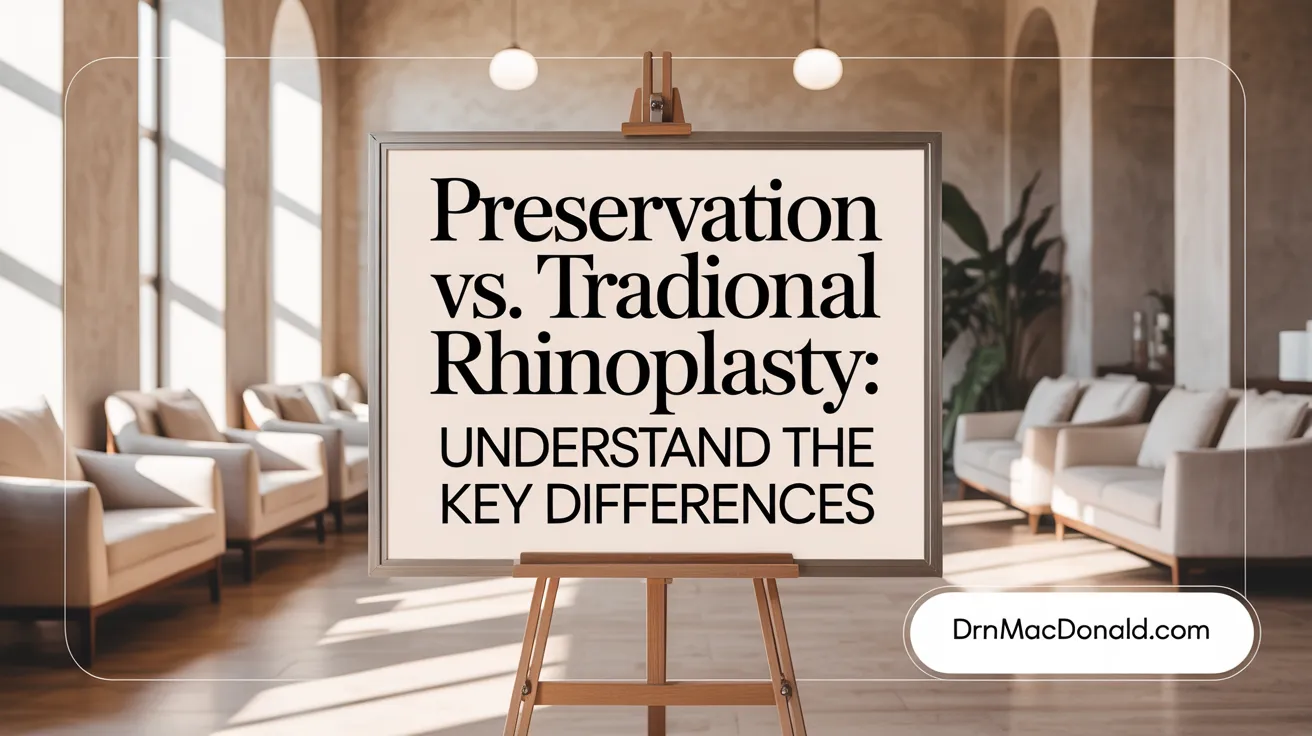Understanding Preservation Rhinoplasty
Preservation rhinoplasty represents a transformative evolution in nasal surgery focused on maintaining the natural architecture of the nose while achieving aesthetic and functional improvements. This modern technique distinguishes itself from traditional rhinoplasty by emphasizing the conservation of nasal bones, cartilage, and ligaments to preserve both appearance and airway function. As patient demand grows for subtle, natural-looking outcomes with reduced recovery times, preservation rhinoplasty is gaining popularity among surgeons and patients alike. This article explores the principles, benefits, surgical techniques, candidate selection, technological advances, and future trends shaping this innovative approach to nose reshaping.
Defining Preservation Rhinoplasty: Principles and Techniques

What is preservation rhinoplasty, and what are its key principles and current techniques?
Preservation rhinoplasty is a contemporary surgical approach centered on maintaining the natural architecture of the nose while enhancing its appearance and function. Unlike traditional rhinoplasty, which often involves extensive removal of cartilage and bone, preservation rhinoplasty aims to work within the existing nasal structures.
Historically dating back to the early 1900s and gaining renewed popularity in recent years, this technique emphasizes minimal tissue disruption (ancient origins of rhinoplasty).
The core principles include conserving the nasal dorsum and ligament attachments, such as the scroll ligament complex, to preserve nasal support and aesthetics. It involves careful elevation of soft tissues in a subperichondrial or sub-SMAS plane, minimizing injury to blood vessels and lymphatics, which reduces swelling and accelerates recovery (subperichondrial–subperiosteal plane elevation).
Current surgical techniques focus on dorsal preservation methods like the "let-down" or "push-down" procedures, which reshape the nasal hump by modifying the structures from below without removing the dorsal bone entirely. This approach preserves the dorsal aesthetic lines, resulting in a position that looks natural and in harmony with the face.
Tip refinement is achieved through cartilage-preserving sutures and minor modifications, avoiding extensive cartilage excisions or grafting whenever possible. Advances also include techniques like the "Spare Roof" method, which preserves the dorsal roof while allowing for reduction of dorsal height.
Overall, preservation rhinoplasty emphasizes tissue conservation, minimally invasive methods, and individualized plans tailored to the patient’s anatomy, leading to long-lasting, natural results with fewer complications and faster recovery (Benefits of preservation rhinoplasty).
Comparing Preservation and Traditional Rhinoplasty

How does preservation rhinoplasty differ from traditional rhinoplasty methods?
Preservation rhinoplasty distinguishes itself from traditional techniques through its conservative approach to nasal reshaping. Instead of removing or extensively reshaping the nasal bone and cartilage, preservation rhinoplasty retains as much of the original nasal structure as possible. This approach involves repositioning existing tissues and making minimal modifications, such as adjusting the internal structures beneath the dorsal line without disrupting the outer contours.
Unlike traditional methods that often involve carving, shaving, or removing parts of the nasal framework to correct deformities or achieve the desired shape, preservation rhinoplasty focuses on subtle changes that maintain the nose’s natural architecture. Surgeons use techniques such as 'let-down' or 'push-down' maneuvers for dorsal hump reduction, preserving the dorsal roof for a smooth profile.
The impact on nasal anatomy and function is also significant. Preservation rhinoplasty helps maintain nasal support and airway pathways, reducing the risk of breathing difficulties often associated with more invasive structural modifications. The technique results in less trauma to surrounding tissues, which contributes to reduced swelling and bruising, and promotes a quicker recovery.
In terms of recovery and complications, preservation rhinoplasty generally involves a shorter healing period with less postoperative swelling and bruising. The preservation of structural integrity lowers the likelihood of destabilizing the nasal framework, thereby decreasing risks such as internal valve collapse or nasal blockage. Complication rates tend to be lower, and long-term stability is often enhanced due to the preserved tissues.
Regarding indications and suitability, preservation rhinoplasty is ideal for patients with a prominent dorsal hump, good skin elasticity, and a naturally balanced nose. It is most effective for subtle to moderate aesthetic improvements, especially when the goal is to refine the nasal profile without extensive structural alteration. Conversely, more complex cases—such as wide noses, irregular dorsal lines, or need for major reshaping—may still require traditional, structural rhinoplasty techniques.
In summary, preservation rhinoplasty emphasizes maintenance of the nose’s natural structure, leading to more natural outcomes, fewer complications, and faster recovery. Traditional methods, however, remain necessary for cases demanding significant reshaping or correction of complex deformities, where extensive tissue removal or reconstruction is unavoidable.
Benefits, Candidate Selection, and Anatomical Considerations

What are the benefits and advantages of preservation rhinoplasty in terms of aesthetic outcomes, recovery times, and nasal function?
Preservation rhinoplasty offers numerous benefits that appeal to both patients and surgeons. Aesthetically, this technique maintains the natural contours of the nose by preserving the dorsal bridge, key ligaments, and cartilage, leading to results that look more natural and harmonious with the face. Unlike traditional methods that may remove or significantly reshape nasal structures, preservation rhinoplasty minimizes disruption, reducing the risk of irregularities and unnatural appearances.
Recovery times are notably shorter with preservation techniques. Since less tissue removal and manipulation are involved, patients often experience less swelling, bruising, and discomfort. This allows for quicker return to normal activities—many patients resume work within just 7 to 10 days—and lowers the likelihood of long-term complications.
Functionally, preserving critical internal structures such as the internal nasal valve and ligament attachments helps maintain or even enhance nasal airflow. This reduces the risk of breathing issues that can sometimes result from more invasive traditional rhinoplasty procedures (functional benefits of preservation rhinoplasty).
Overall, preservation rhinoplasty strikes a balance between aesthetic refinement and functional integrity, making it an increasingly preferred approach for suitable candidates.
Who are the suitable candidates for preservation rhinoplasty, and what eligibility criteria are considered?
Ideal candidates for preservation rhinoplasty are individuals seeking subtle aesthetic enhancements, such as reducing dorsal humps or refining nasal tips, while aiming to retain the nose’s natural look and function. They typically have a straight septum, healthy nasal tissues, and no major deformities or previous wide surgical alterations.
Candidates should ideally be in good overall health without active infections or complex anatomical deformities. It is essential they have realistic expectations, understanding that preservation rhinoplasty is most effective for minor to moderate corrections rather than extensive reshaping.
Patients who desire a quicker recovery or wish to avoid the risks of structural weakening are also suitable. Conversely, those requiring significant modifications, like correcting a wide or severely crooked nose, may be better served with traditional or structural rhinoplasty (differences between preservation and structural rhinoplasty).
A thorough consultation with a qualified, board-certified surgeon is crucial to assess individual anatomy and determine eligibility.
What anatomical points and nasal conditions are important considerations during preservation rhinoplasty surgery?
Successful preservation rhinoplasty hinges on a detailed understanding of nasal anatomy. Key points include the dorsal septal area, the keystone region (where the nasal bones and cartilage meet), and the lateral cartilages—both upper and lower.
Surgeons evaluate the condition of the dorsal aesthetic lines to ensure they can be preserved without creating irregularities or dorsal deformities. The septum, especially the caudal septal strut, must be healthy enough to support preservation strategies.
Dorsal humps are addressed by techniques such as controlled lowering or reshaping from within, avoiding complete removal of the dorsal bone (dorsal preservation rhinoplasty techniques). Preservation of the internal nasal valve is vital for airflow, often maintained through strategic use of cartilage grafts or flaps rather than structural removal.
Conditions like nasal deviation, thick skin, and previous trauma influence the surgical approach. In cases with a deviated septum, stabilization and correction may involve minimal resection or cartilage repositioning, all aimed at maintaining structural support.
Assessing these anatomical structures carefully ensures the functional and aesthetic success of preservation rhinoplasty, making individualized planning essential (preservation rhinoplasty components and anatomy).
Surgical Approaches and Technological Innovations in Modern Rhinoplasty
What are the surgical approaches and techniques used in modern nose surgery, including the differences between open, closed, and minimally invasive rhinoplasty?
Modern rhinoplasty primarily utilizes two main surgical approaches: open rhinoplasty and closed rhinoplasty techniques. Open rhinoplasty involves making a small incision across the columella, the tissue between the nostrils, which allows for direct visualization of the nasal structures. This approach is especially beneficial for complex cases, revision surgeries, or when significant reshaping is needed, as it provides precise control.
In contrast, closed rhinoplasty involves incisions made inside the nostrils, leaving no external scars. This method typically results in shorter surgery duration and less postoperative swelling, making it suitable for minor corrections, such as dorsal hump reduction or minor tip adjustments.
Beyond these traditional approaches, minimally invasive rhinoplasty techniques are increasingly common. These methods use smaller incisions and employ advanced tools, relying on tissue preservation to reduce trauma and recovery time. Techniques such as preservation rhinoplasty focus on adjusting existing structures with minimal tissue removal, leading to more natural results and quicker healing.
The choice between open, closed, or minimally invasive rhinoplasty depends on the patient's specific nasal issues, aesthetic goals, and the surgeon's expertise. A detailed consultation helps determine the most suitable approach for each individual (Choosing a rhinoplasty surgeon).
What technological advancements and innovations have influenced rhinoplasty techniques, including imaging, laser, ultrasound, and robotic surgery?
Recent technological innovations have revolutionized rhinoplasty, elevating the precision, safety, and predictability of outcomes. High-resolution 3D imaging and virtual simulation software allow surgeons and patients to visualize potential results preoperatively, enhancing planning accuracy and setting realistic expectations.
Laser technologies facilitate precise cuts and tissue sealing during surgery, reducing bleeding and minimizing postoperative swelling. Ultrasound-assisted (piezosurgery) techniques utilize ultrasonic vibrations to sculpt nasal bones more accurately, causing less damage to surrounding tissues, and resulting in faster recovery.
Robotic systems and computer-aided devices provide heightened control and stability during complex procedures. These systems enable minimally invasive interventions, particularly valuable in reconstructive or intricate aesthetic cases. 3D printing is also increasingly used to create custom implants and surgical guides, tailored precisely to each patient's anatomy.
Emerging fields such as artificial intelligence are beginning to influence technique selection and surgical planning, allowing for predictive modeling of outcomes and personalized surgical approaches. Collectively, these technological advances continue to improve the safety, efficiency, and quality of rhinoplasty.
More about modern rhinoplasty techniques and technology
| Technique/Technology | Impact | Benefits | Limitations |
|---|---|---|---|
| 3D Imaging & Software | Precise planning & visualization | Better patient understanding & expectation management | Requires advanced equipment |
| Laser & Ultrasound | Precise tissue/bone sculpting | Reduced bleeding, swelling, recovery time | Costly, learning curve |
| Robotic Surgery | Enhanced control & accuracy | Suitable for complex cases | High cost, availability |
| 3D Printing | Custom implants & guides | Tailor-made solutions | Production time |
| AI & Predictive Modeling | Personalized planning | Optimized outcomes | Still early-stage development |
Understanding these advances helps explain why modern rhinoplasty offers safer, more precise, and more natural outcomes, aligning surgical success with patient satisfaction.
Recovery, Risks, and Postoperative Care of Preservation Rhinoplasty
What is the typical recovery process and healing timeline following preservation rhinoplasty?
The process of healing after preservation rhinoplasty generally begins immediately following surgery. Most patients experience an initial recovery phase lasting about one week. During this period, swelling, bruising around the eyes and nose, nasal congestion, and the presence of a nasal splint or cast are common. Swelling generally peaks within days 3 to 7 and begins to diminish significantly by weeks 2 to 4. Patients are often able to resume light activities, including returning to work, within approximately 7-10 days.
Over the ensuing months, swelling continues to decrease gradually, and the nasal shape and function improve visibly. Full stabilization of the final aesthetic and functional results typically takes between 6 and 12 months. During this time, subtle changes in the appearance of the nose continue as tissues settle. Proper postoperative care—such as elevating the head while sleeping, avoiding strenuous activities or facial expressions that could disturb healing, and attending scheduled follow-up visits—is crucial for smooth recovery. Patience and diligent adherence to care instructions are essential, as the ultimate refined results become evident gradually over the course of a year. For more details on Rhinoplasty recovery timeline and Postoperative care for rhinoplasty, these resources offer comprehensive guidance.
What are the potential risks, complications, and challenges associated with preservation rhinoplasty?
While preservation rhinoplasty is generally considered safe, it does involve specific risks and potential complications. These include nasal asymmetry, persistent swelling, and breathing difficulties if internal structures are inadvertently affected. Infection, although rare, remains a possible complication requiring prompt treatment.
One of the main challenges is selecting appropriate candidates and executing precise surgical techniques. Improper preservation of nasal support structures can lead to deformities such as the "pollybeak" deformity or dorsal irregularities. Technical expertise is critical to avoid issues like graft displacement or resorption, which can compromise both appearance and function. Understanding differences in structure preservation techniques and indications is key to success.
Serious complications are uncommon but can be significant. Vascular injuries may lead to tissue necrosis, and although extremely rare, cerebrospinal fluid leaks could occur if the dura is breached during advanced procedures. Infection risk is minimized with meticulous sterile technique, but intraoperative or postoperative infections can be difficult to manage. Awareness of possible rhinoplasty risks and complications is important for both patients and surgeons.
Overall, success depends greatly on thorough preoperative assessment, understanding individual anatomy, and surgeon experience. Ensuring patients are well-informed about these potential risks enables realistic expectations and better outcomes. For detailed discussion on preservation rhinoplasty complications and considerations, this resource provides valuable insights.
Future Directions and Expert Perspectives on Preservation Rhinoplasty
Looking ahead, the field of nasal surgery is poised to incorporate a wide array of innovative technologies and techniques. Surgeons anticipate greater integration of computer-assisted surgical planning, which uses 3D imaging and virtual reality to visualize postop results with high precision. Augmented reality tools are also being explored for intraoperative guidance, helping surgeons navigate complex anatomy more safely.
Emerging methods in regenerative medicine are transforming possibilities. Tissue engineering, stem cell research, and 3D printing enable the creation of custom implants that fit precisely into the nasal framework, reducing the risk of rejection and the need for revision surgeries. These advances promise faster healing, less scarring, and more durable aesthetic outcomes.
Minimally invasive procedures are expected to become more prevalent. Ultrasonic rhinoplasty, employing piezosurgery for bone reshaping, offers precise cuts with minimal trauma—leading to shorter recovery times. Laser-assisted techniques further reduce bleeding and swelling, enhancing patient comfort.
Within this landscape, preservation rhinoplasty, which focuses on maintaining the existing nasal structures, is experiencing a resurgence. While traditionally used for subtle corrections, experts see potential for broader application by combining preservation principles with structural support techniques. The hybrid approach leverages the strengths of both methods—preserving natural dorsal lines and nasal support while allowing for necessary modifications.
Experts emphasize that careful patient selection remains vital. Preservation rhinoplasty is most suitable for those with prominent humps, good skin elasticity, and no prior nasal trauma or surgery. Surgeons also stress that mastering these advanced techniques requires specialized training and experience to achieve predictable, lasting results.
Overall, the future of nasal surgery is characterized by a convergence of technology, tissue engineering, and preservation principles. These innovations aim not only to enhance aesthetic and functional outcomes but also to make procedures safer, less invasive, and more accessible to a diverse range of patients. As research progresses, the integration of AI and 3D printing will likely revolutionize patient-specific treatments, cementing preservation rhinoplasty’s role in modern nasal surgery.
The Future of Nose Surgery Embracing Preservation
Preservation rhinoplasty represents a noteworthy advancement in nasal surgery, aligning aesthetic finesse with functional integrity by conserving natural nasal anatomy. This method not only offers patients more authentic, harmonious results but also a faster and safer recovery experience. As technological innovations and surgical techniques continue to evolve, preservation rhinoplasty is poised to become an integral component of personalized nasal surgery strategies. However, its successful application depends on meticulous patient selection and specialized surgeon expertise. Looking ahead, the integration of regenerative medicine, artificial intelligence, and minimally invasive technologies promises to refine preservation rhinoplasty further, broadening its indications and enhancing patient outcomes. Ultimately, this approach underscores a new era of nose surgery that reveres nature's design while catering to modern aesthetic and functional desires.
